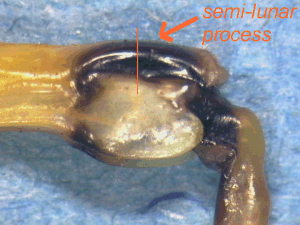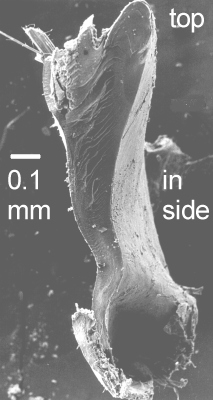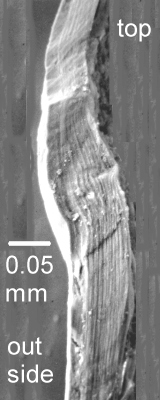
Where does the grasshopper keep its catapult?
The pictures below show the joint region of a back leg (left) and, for comparison, a middle leg (right). The most obvious difference between the two is the dense black half-moon shaped region (the semi-lunar process) at the top part of the joint of the back leg. This is the external view of a pair of springs, one on each side of the leg, made from special cuticle. (Cuticle is the name of the material which makes the exoskeleton of an insect.) These processes are only found on the back legs - they are completely missing from the front and middle legs.

A comparison of the spring cuticle shows it is highly specialised compared to normal cuticle.
On the left below is a scanning electron micrograph of one of the springs which has been cut in half along the red line shown in the photograph of the knee joint above. The spring cuticle is extremely uniform in consistency, almost glass-like. This makes it very stiff, and thus it is able to store a lot of energy for a relatively small amount of bending (like strong elastic in a catapult). On the right is a similar micrograph, but this time of normal cuticle taken from a slice of the tibia. This cuticle is obvious layered, and not at all uniform in consistency. It is quite strong in the sense that it will not easily break, but it is very bendy and flexible, and would be no use at all for storing energy.


The layers visible in the tibial cuticle are growth layers, a bit like the growth rings of a tree, except each layer is laid down in a 24-hour period. The insect continuously grows new cuticle (albeit at a decreasing rate), and the cuticle which it grows at night has a different molecular orientation to the cuticle which it grows by day. This means that by counting the number of layers of cuticle one can determine the number of days which have passed since the insect last moulted.
We could see the springs in action if we were to look closely at the knee joint during a jump. However, it isn't easy to photograph a grasshopper's knees while it jumps, so instead I've videoed the knee joint of one leg during a kick. Grasshoppers use their back legs as defensive weapons, and can give vigorous kicks using exactly the same process as they do when they jump, except that they angle their legs at their target, rather than the ground.
Here are videos of the knee joint of two legs during a kick. Note how the spring and the whole distal part of the femur distort:
The springs in the knee joint are the most obvious discrete anatomical structures where energy is stored, and they store about half the total energy for the jump. The rest is stored in generalised distortion of the external cuticle and internal tendons, spread across the whole structure of the femur.
Now we know where the elastic of the grasshopper catapult is. The next question, is how does it all work?